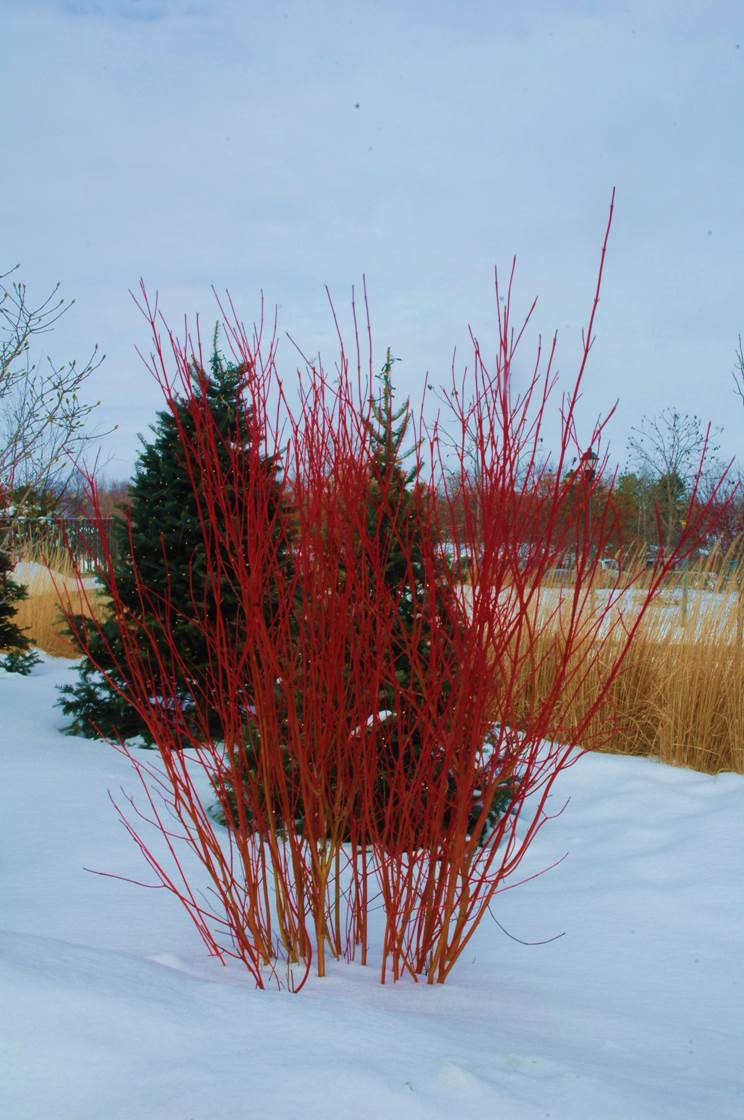By Margo Dameier
OSU Hood River County Extension Central Gorge Master Gardener volunteer
As I drive to and from winter recreation sites in the Central Gorge and nearby mountains, I can’t help but notice the native plants that also call this area home. Some of them have been planted by homeowners, while others are arranged by Mother Nature. No matter how they became rooted in their locations, they all look spectacular as part of the Northwestern winter landscape.
The winter solstice has ushered us into the season of limited daylight hours. Most plants are in their seasonal slumber and frequent clouds with various types of precipitation fill the sky. Having a bit of structure and color or an early blooming shrub in your home landscape can brighten your view and offer joy on a winter day. Native plants require very little care when they’re planted in the right conditions and will grace your landscape with their charms year round.
Deciding what native plants to add to your winter landscape starts with surveying your outdoor capacity now. Is there a void of winter interest and color in one or more areas? How much space do you have to work with? What soil conditions, water availability, and light exposures are present? By knowing the answers to these questions you’ll be able to successfully select carefree native shrubs that will adorn your landscape for years to come.
There are many native plants that are suitable for home landscapes and in the winter months the color red catches our eye. Here are three native plants that offer red as a contrast to whatever winter weather is occurring outdoors.
Red Stem Ceanothus in a natural winter setting
Red Stem Ceanothus, Ceanothus sanguineus is also known as Oregon Tea Tree, and provides welcome winter color with its reddish-purple stems. This alone is reason enough to plant it in your landscape! As a bonus you’ll also get bright green oval leaves in the spring and wonderfully fragrant elongated clusters of tiny white flowers from late spring to midsummer that attract butterflies, bees and hummingbirds to your landscape. This sturdy upright deciduous shrub grows well in sunny sites, but will tolerate part shade. It prefers dry to moist well drained soil that’s rocky, sandy or loamy, and is a great selection for dry pollinator gardens. Add it to a hedge row where it will be a superstar native plant, or allow it to control erosion on slopes while it fixes nitrogen in poor soil. Red Stem Ceanothus also provides seeds for many birds and small mammals, attracts and supports beneficial insects, and is a host and larval food source for about two dozen types of caterpillars including Ceanothus Silkmoth and Hedgerow Hairstreak butterfly.
This beautiful and beneficial native plant has a slow growth rate, and when planted in the right conditions can grow to be 3’ – 10’ tall and up to 10’ wide and requires minimal pruning. Keep in mind that it will struggle to survive if planted in heavy or clay soils and that deer and rabbits love to eat the foliage.
Red Osier Dogwood in Winter
Red Osier Dogwood, Cornus sericea, is also known as Red Twig Dogwood and is a native plant that has bright red bark in winter with abundant white flowers in the spring that become white berries in late summer. These berries can last through the winter months and are a valuable food source for wildlife. This versatile native shrub can be planted near a wetland area with full sun where it will create an attractive thicket, or grown as an individual shrub in moist soil under a closed canopy or among deciduous trees. Either way, Red Osier Dogwood will provide beautiful year round interest. This is a fast growing native plant, adding about a foot of new growth each season and reaching heights of 6 – 9’ with a spread of 8’ – 12’. Since it likes moist soil, it will need supplemental water in the dry months. To control its spread and keep the bark fresh and bright in the winter, cut the shrub to the ground in the spring to encourage new growth. Another pruning technique is to cut out the oldest branches, no more than one-third of the total plant, every year or two.
Even though red bark on wispy stems is a stunning addition to the winter landscape, colorful late fall foliage with late winter to early spring blooms are also a welcome sight. If early blooms sound good to you, consider planting Red Flowering Currant, Ribes sanguineum. This deciduous shrub not only keeps its colorful leaves into early winter, it will bloom for a short time between November and March, depending on its location. The Red Flowering Currents that are planted in the Native Garden on the OSU Hood River Extension campus are shaded by huge Fir and Cedar trees and their blooms start to appear in late February or early March. Less than a mile away, the Red Flowering Currents that are planted in full sun at the Hood River Valley Adult Center curb garden start to bloom two or more weeks earlier. These lovely red blooms are short lived before withering. However, they remain on the small berries as they develop. These berries change color throughout the summer and into fall. Starting as green they turn to yellow before easing into red and finally turning purple. When ripe, birds will be flocking to these berries as they are a favorite food source. Red Flowering Currant prefers a mild, dry climate in sun or part shade with well drained average to poor soil. No fertilizer is needed but adding some compost at the time of planting will encourage root development and provide more abundant blooms. This native shrub is beautiful, fast growing, and offers structure in the landscape with its upright, vase shaped growth habit. It will reach a height of 6’ – 8’ and a width of 6’ – 10’. Red Flowering Currant is an easy care native plant as pruning is not needed. However, if you’re looking for a neat, compact plant with abundant blooms, prune off up to one-third of its height after the flowers fade.
Red Flowering Currant winter foliage
Please don’t limit yourself to this short list of native shrubs for winter color as there are so many more native plants to choose from. We live in an area with four distinct seasons and there are native plants that offer beauty in all of them. Go ahead and select some plants that offer interest in other seasons too. For an extensive list of native plants of the Pacific Northwest visit, https://extension.oregonstate.edu/gardening/techniques/pacific-nw-native-plants-plant-community
Another helpful resource from OSU Extension Service is https://extension.oregonstate.edu/collection/native-plant-gardening
Fall is my preferred time to plant trees and shrubs as it allows the plants time to develop roots during the wet winter months while the plant is dormant. However, spring is the time when most people are excited about planting and plants are most readily available. When planting in the spring and summer, allow your native plants to become well established by giving them consistent water through the dry months and provide temporary shade if our temperatures spike.
We are fortunate to have native plants available through reputable nurseries and plant sales. As you begin to make plans for which native plants you’d like to add to your landscape, there are two local plant sales that I’d like to call your attention to.
The Hood River Soil and Water Conservation District (SWCD) holds a native plant sale every year where bare root plants are sold. Pre-orders for conifers, deciduous trees and shrubs will begin January 2, 2025 through https://hoodriverswcd.org/plant-sale/.
Order pick up and days of the sale are April 4 & 5 at 3007 Experiment Station Road in Hood River where additional bare root plants and potted native wildflowers will be available. Wasco County and Underwood Conservation Districts will also offer native plants sales in the winter and spring.
The Central Gorge Master Gardener Associations’ annual Spring Plant Sale will have a selection of potted native shrubs that have been requested by our customers. The CGMGA annual Spring Plant Sale will be held on Saturday, May 10 (the day before Mother’s Day) at the Master Gardener greenhouse on the OSU Hood River Extension campus, 2990 Experiment Station Road. Central Gorge Master Gardeners also offer a wide selection of vegetables, herbs, and annual, perennial and native flowers that are selected specifically for the various climates in the Central Gorge. The popular Kids’ Corner activities and Garden Gathering pop up workshops will also be held during the sale. More detailed information will be listed in the Columbia Gorge News, as well as on Facebook and Instagram. The Central Gorge Master Gardener Association has a new website, https://centralgorgemga.org/ where details on the Spring Plant Sale and other Master Gardener news and events will be posted as they become available.
Central Gorge Master Gardener volunteers provide free beginning gardening classes and continuing education to home gardeners. For research based information about specific gardening or pest questions, submit your concern online at extension.oregonstate.edu/mg/hoodriver or by phone at 541-386-3343. Home gardeners can also drop off plant or pest samples Monday – Thursday between 9 AM and 4 PM at the OSU Hood River County Extension Service, 2990 Experiment Station Drive, Hood River, OR.
The Central Gorge Master Gardener program is a division of the OSU Hood River County Extension Service. OSU Extension Service prohibits discrimination in all its programs, services, activities, and materials.


Leave a Reply